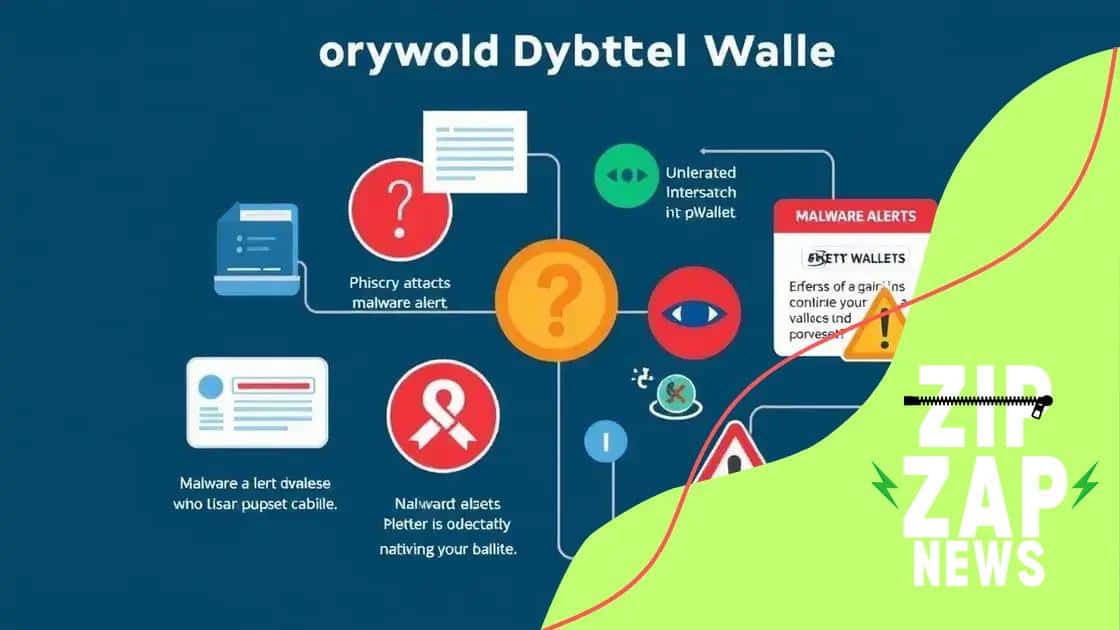Digital wallets and their financial security: Are you safe?

Digital wallets offer convenience but come with risks like hacking and phishing; securing them requires strong passwords, multi-factor authentication, and regular updates to ensure financial safety.
Digital wallets and their financial security have become essential in our increasingly cashless society. But have you ever wondered how secure your online transactions truly are? In this article, we’ll explore the ins and outs of digital wallet safety.
Understanding digital wallets
Digital wallets have transformed the way we handle money. They allow users to store payment information securely on their devices, making transactions quicker and more convenient than ever.
When we talk about digital wallets, we refer to applications or services that allow users to make electronic transactions. Whether you’re paying for groceries or transferring money to a friend, digital wallets have simplified the process.
What are digital wallets?
A digital wallet stores your payment methods, such as credit cards and bank account information. Instead of carrying physical cards, you can use your phone to pay.
Additionally, digital wallets often come with enhanced security features like encryption and multi-factor authentication. This means your information is stored securely, reducing the risk of fraud.
How do digital wallets work?
To use a digital wallet, you first need to download an app, like Apple Pay or Google Wallet. After setting up your account, you add your payment information. When it’s time to make a purchase, you can pay by scanning a QR code or tapping your phone on a compatible terminal.
This seamless experience is one of the reasons why many people prefer digital wallets. They combine convenience with the security needed in today’s digital world.
Overall, understanding digital wallets is essential in our cashless society. They provide a way to manage payments that is easy and secure, allowing users to embrace new technology confidently.
Key features of financial security
Understanding the key features of financial security is essential when using digital wallets. These features help protect users from fraud and safeguard their sensitive information.
One of the most vital elements is encryption. This process secures your data, making it hard for hackers to access personal payment information. Digital wallets use strong encryption methods to keep your transactions safe.
Multi-factor authentication
Another important feature is multi-factor authentication (MFA). This method requires users to provide two or more verification factors to gain access. For example, after entering a password, you may also need to enter a code sent to your phone.
This extra step is crucial because even if someone obtains your password, they cannot access your wallet without the second factor.
Transaction alerts
Digital wallets often include transaction alerts. These notifications inform users whenever a transaction occurs. Whether it’s a purchase or a transfer, knowing instantly can help you spot any unauthorized activity.
By being aware of these transactions, you can maintain better control of your finances and respond quickly to suspicious activities.
Another essential feature is biometric security, such as fingerprint scanning or facial recognition. These methods enhance security by ensuring that only you can access your wallet. This makes it tougher for anyone else to gain unauthorized access, adding another layer of safety.
In summary, the key features of financial security in digital wallets include encryption, multi-factor authentication, transaction alerts, and biometric security. These elements work together to create a secure environment for managing your finances.
Common risks associated with digital wallets

While digital wallets offer convenience, it is crucial to understand the common risks associated with digital wallets. Awareness can help users take steps to protect their financial information.
One major risk is hacking. Cybercriminals target digital wallets, aiming to steal sensitive data and funds. This can happen through phishing attacks or insecure networks.
Phishing attacks
Phishing is when fraudsters trick users into giving away personal information. They often use fake emails or websites that look legitimate. Always double-check links and emails before entering details.
Another threat is malware. Malicious software can be installed on a user’s device without their knowledge. This can lead to unauthorized access to your digital wallet.
Unsecured networks
Using public Wi-Fi can expose your financial data. When connected to an unsecured network, hackers can easily intercept transactions. It’s better to use a secured, private network when accessing your digital wallet.
Social engineering is another risk associated with digital wallets. Scammers may impersonate someone you trust to obtain information. Stay vigilant and be cautious of sharing any sensitive details.
Finally, the lack of security updates can also put users at risk. Keeping the app and device updated is crucial. Updates fix vulnerabilities that could be exploited by attackers, ensuring that your digital wallet remains secure.
By recognizing these common risks, users can implement strategies to protect themselves. Awareness is key to safely enjoying the benefits of digital wallets.
Best practices for securing your wallet
Securing your digital wallet is vital to protect your finances. Understanding the best practices for securing your wallet helps prevent fraud and unauthorized access.
One important method is using strong passwords. Avoid simple or common passwords. Instead, create a password that combines letters, numbers, and special characters for added security. This makes it harder for hackers to guess.
Enable multi-factor authentication
Another effective strategy is enabling multi-factor authentication (MFA). This requires additional verification beyond just a password. For example, you may receive a text with a code you need to enter before gaining access to your wallet.
MFA acts as a barrier, ensuring that even if someone has your password, they would still need the second factor to log in.
Keep your software updated
Regularly updating your wallet app and device software is crucial. Updates often include security patches that fix vulnerabilities. Always keep both the app and your device’s operating system up to date.
Failing to update can leave your wallet exposed to potential threats.
Be cautious of public Wi-Fi networks as well. When using a digital wallet, always connect to secured networks. If you have to use public Wi-Fi, consider using a virtual private network (VPN) for added security.
Another important practice is regularly monitoring your account statements. Keep an eye on transactions and promptly report any suspicious activity. This helps catch unauthorized transactions early.
Use reputable digital wallets
Lastly, choose a digital wallet from a reputable provider. Research users’ reviews and ratings before making your selection. A trusted wallet ensures better security features and customer support.
By following these best practices for securing your wallet, users can significantly reduce their risk of falling victim to fraud and cyber threats.
Future trends in digital wallet security
The future of digital wallet security looks promising as new technologies emerge. Understanding the future trends in digital wallet security is crucial for users wanting to stay ahead of threats.
One exciting trend is the use of artificial intelligence (AI). AI can analyze transaction patterns and detect unusual activities. This helps in identifying fraud before it affects users.
Biometric authentication
Another technology gaining traction is biometric authentication. This includes using fingerprints, facial recognition, and even voice recognition. Biometric methods provide a secure way to verify a user’s identity.
As technology advances, these authentication methods will likely become standard features in digital wallets.
Blockchain technology
Blockchain technology is also influencing digital wallet security. It offers a decentralized way to record transactions. This can enhance security by making it difficult for hackers to alter transaction records.
As more wallets adopt blockchain technology, users can expect greater security and verification of their transactions.
Another trend is the integration of machine learning. Machine learning algorithms can continuously improve security measures by adapting to new threats. This ongoing learning helps digital wallets stay secure against evolving cyber risks.
Moreover, privacy regulations are becoming stricter. Wallet providers will need to comply with these regulations to enhance user trust. Users are also more aware of their data privacy, pushing companies to focus on user-friendly privacy tools.
Tokenization
Tokenization is set to play a significant role as well. It replaces sensitive data with a unique identifier, or token, which can reduce the risk of data breaches. By using tokens instead of real account numbers, the potential for fraud decreases significantly.
In summary, the future trends in digital wallet security will include advancements in AI, biometric authentication, blockchain technology, machine learning, increased privacy regulations, and tokenization. These innovations will create a more secure digital environment for users.
FAQ – Frequently Asked Questions about Digital Wallets
What are digital wallets?
Digital wallets are applications that allow users to store payment information securely on their devices for easy and convenient transactions.
How can I secure my digital wallet?
You can secure your digital wallet by using strong passwords, enabling multi-factor authentication, and keeping your software updated.
What risks are associated with digital wallets?
Common risks include hacking, phishing attacks, malware, and the use of unsecured networks.
What future trends should I be aware of for wallet security?
Future trends in digital wallet security include advancements in AI, biometric authentication, blockchain technology, and tokenization.





